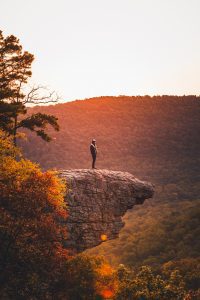Words by BTV Director of Programs & Events Riki Stamps
Growing up in Southeast Arkansas, the foundation of my childhood and teen memories was built on time spent roaming the flat upland mixed pine-hardwood forests with my family, as we camped, hunted or explored. The peaceful wind blowing through the white pine trees is permanently etched in my memory.
I visited Fayetteville for the first time in 1978, trying to decide between the University of Arkansas and Arkansas State University. The drive from Pine Bluff was at night, and when we crested the hill on winding old Highway 71, the lights of Fayetteville dotting the city mountains and valleys were a vision I will never forget. Following my time at ASU, I married a young man from Springdale and we settled in Fayetteville. Over the decades, I have visited many locations in and around what is known as the Ozarks – a place full of history and beauty. The Ozarks are my forever home; there is much more to learn about the beautiful secrets of the past, human presence and historical events surrounding us. Forever the adventurer, I am excited for Butterfield residents to join me in uncovering all there is to experience in our gorgeous region – a very special journey we will present through a new series of lectures and destinations called Aux Arcs to Ozarks.
The word “Ozark” derives from the corrupted French “aux-arcs,” a shortened form of a term that likely meant “to (or toward) the Arkansas Post” or that referred to the area where Arkansas (Quapaw) Indians resided near this early French post in the Arkansas River delta. The Ozarks, also known as the Ozark Mountains or Ozark Plateau, actually extends across five states: Missouri, Arkansas, Oklahoma, Kansas and Illinois. The majority of the region falls in Southern Missouri and Northern Arkansas.
The Ozarks are subdivided into four smaller areas: the Springfield Plateau, Boston Mountains, Salem Plateau and St. Francois Mountains. These expanses represent the largest area of rugged topography between the Appalachians and the Rockies. The Boston Mountains in Northwest Arkansas feature the highest peaks of the Ozark Mountains, many exceeding 2,000 feet. Some of these mountains – including Mount Magazine, the tallest mountain in Arkansas – are found within the Ozark National Forest.
It is remarkable to consider that the Ozarks were once covered by ocean. Dr. Matt Covington, Associate Professor of Geology at the University of Arkansas, will be our first presenter on the topic of geomorphology, the scientific study of the origin and evolution of the Earth’s surface. Using field observations, physical experiments and numerical modeling, geomorphologists strive to understand what causes landscapes to have their particular physical characteristics. Through the study of landform, terrain history and dynamics, these scientists explain the past – and also help predict future changes destined for the land we inhabit.

Archeological evidence has shown that Paleo-Indians, also known as Bluff Dwellers, likely lived in the Ozarks during the last ice age, between 12,000 to 14,000 years ago. Following the Paleo-Indian period, scores of tribes such as Kaskaskia, Cahokia, Peoria and Saukees inhabited the eastern Ozarks. Toward the western part of the region, Shawnee, Pawnee, Osage and Choctaw tribes – just to name a few – made the area their home. Following the Louisiana Purchase, the United States government’s voluntary and forced westward relocation of additional tribes like the Cherokee, Chickasaw, Creek and Seminole brought more Native Americans into portions of the Ozarks, with the best-known act of Indian-remova
l resulting in the deadly Trail of Tears through Arkansas and into Oklahoma. We will be learning about some of these beautiful cultures in an effort to gain a better understanding and deeper appreciation of the values, traditions and beliefs of the Native people of the Ozarks.
“Geologic forces raised the Ozarks. Myth enshrouds these Ozarks,” says Dr. Brooks Blevins, Noel Boyd Professor of Ozarks Studies at Missouri State University. He will present a lecture on “The Old Ozarks” and touch upon colorful stories about places and people that influenced and perpetuated myths and misunderstandings about the region that persist even today. From the days when the hill country was the hunting ground of the Osage to the log-cabin bear hunters and pioneers of the early 1800s, Blevins will introduce us to the Ozarks as it was before the Civil War.

Our Aux Arcs to Ozarks series will include day trips to experience our stunning national forests, as well as view historical sites mentioned by guest speakers. We’re planning fun overnight adventures in Missouri and Oklahoma, as well as visiting charming Mountain View, Ark., where Appalachian culture m
ade a prominent mark on the folk music associated with the Ozarks for generations.
Director of the Arkansas Archeological Survey Dr. George Sabo will talk with us about the fascinating Osage Nation – and we will learn about European exploration and settlement by the Spanish, French and Germans. We’ll spend time discovering details about the Civil War in the Ozarks, plus delve into even more evolving topics and excursions to be scheduled through the end of the year.
I hope you’ll join me on this quest to embrace our beloved Ozarks history and culture, and I can’t wait for us to learn more together!
